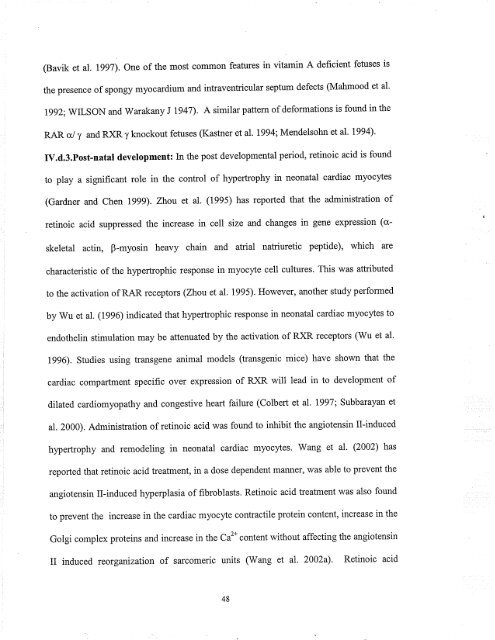il\VOLVEMENT OF RETII\OIC ACID II{ - MSpace at the University of ...
il\VOLVEMENT OF RETII\OIC ACID II{ - MSpace at the University of ...
il\VOLVEMENT OF RETII\OIC ACID II{ - MSpace at the University of ...
You also want an ePaper? Increase the reach of your titles
YUMPU automatically turns print PDFs into web optimized ePapers that Google loves.
(Bavik et al. 1997). One <strong>of</strong> <strong>the</strong> most common fe<strong>at</strong>ures in vitamin A deficient fetuses is<br />
<strong>the</strong> presence <strong>of</strong> spongy myocardium and intraventricular septum defects (Mahmood et al'<br />
1992;W1LSON and Warakany J 1947). A similar p<strong>at</strong>tern <strong>of</strong> deform<strong>at</strong>ions is found in <strong>the</strong><br />
RAR crl y and RXR y knockout fetuses (Kastner et al. 1994; Mendelsohn et al. 1994)'<br />
IV.d.3.Post-n<strong>at</strong>al development: In <strong>the</strong> post developmental period, retinoic acid is found<br />
to play a significant role in <strong>the</strong> control <strong>of</strong> hypertrophy in neon<strong>at</strong>al cardiac myocytes<br />
(Gardner and Chen lggg). Zhot et al. (1995) has reported th<strong>at</strong> <strong>the</strong> administr<strong>at</strong>ion <strong>of</strong><br />
retinoic acid suppressed <strong>the</strong> increase in cell size and changes in gene expression (askeletal<br />
actin, B-myosin heavy chain and <strong>at</strong>rial n<strong>at</strong>riuretic peptide), which are<br />
characteristic <strong>of</strong> <strong>the</strong> hypertrophic response in myocyte cell cultures. This was <strong>at</strong>tributed<br />
to <strong>the</strong> activ<strong>at</strong>ion <strong>of</strong> RAR receptors (Zhot et al. 1995). However, ano<strong>the</strong>r study performed<br />
by'Wu et al. (1996) indic<strong>at</strong>ed th<strong>at</strong> hypertrophic response in neon<strong>at</strong>al cardiac myocytes to<br />
endo<strong>the</strong>lin stimul<strong>at</strong>ion may be <strong>at</strong>tenu<strong>at</strong>ed by <strong>the</strong> activ<strong>at</strong>ion <strong>of</strong> RXR receptors (Wu et al.<br />
1996). Studies using transgene animal models (transgenic mice) have shown th<strong>at</strong> <strong>the</strong><br />
cardiac compartment specific over expression <strong>of</strong> RXR will lead in to development <strong>of</strong><br />
dil<strong>at</strong>ed cardiomyop<strong>at</strong>hy and congestive heart failure (Colbert eI al. l99l; Subbarayan et<br />
a1. 2000). Administr<strong>at</strong>ion <strong>of</strong> retinoic acid was found to inhibit <strong>the</strong> angiotensin ll-induced<br />
hypertrophy and remodeling in neon<strong>at</strong>al cardiac myocytes. Wang et al' (2002) has<br />
reported th<strong>at</strong> retinoic acid tre<strong>at</strong>ment, in a dose dependent manner, was able to prevent <strong>the</strong><br />
angiotensin Il-induced hyperplasia <strong>of</strong> fibroblasts. Retinoic acid tre<strong>at</strong>ment was also found<br />
to prevent <strong>the</strong> increase in <strong>the</strong> cardiac myocyte contractile protein content, increase in <strong>the</strong><br />
Golgi complex proteins and increase in <strong>the</strong> Ca2* content without affecting <strong>the</strong> angiotensin<br />
<strong>II</strong> induced reorganiz<strong>at</strong>ion <strong>of</strong> sarcomeric units (Wang et al. 2002a). Retinoic acid<br />
48







![an unusual bacterial isolate from in partial fulf]lment for the ... - MSpace](https://img.yumpu.com/21942008/1/190x245/an-unusual-bacterial-isolate-from-in-partial-fulflment-for-the-mspace.jpg?quality=85)





![in partial fulfil]ment of the - MSpace - University of Manitoba](https://img.yumpu.com/21941988/1/190x245/in-partial-fulfilment-of-the-mspace-university-of-manitoba.jpg?quality=85)


